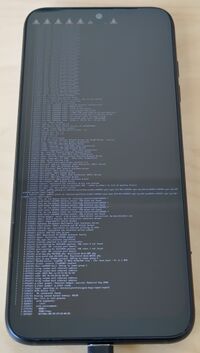Fairphone 4 (fairphone-fp4): Difference between revisions
Wifi works fully |
|||
| Line 18: | Line 18: | ||
| status_touch = Y | | status_touch = Y | ||
| status_screen = Y | | status_screen = Y | ||
| status_wifi = | | status_wifi = Y | ||
| status_xwayland = | | status_xwayland = | ||
| status_fde = | | status_fde = | ||
| Line 81: | Line 81: | ||
Please note that the device does not contain a <code>system</code> as you might be used to, it contains one <code>super</code> partition which contains <code>system</code>/<code>system_ext</code>/<code>product</code>/<code>vendor</code>/<code>odm</code> partitions, in _a and _b variant each. This concept is called [https://source.android.com/devices/tech/ota/dynamic_partitions/implement Dynamic Partitions]. | Please note that the device does not contain a <code>system</code> as you might be used to, it contains one <code>super</code> partition which contains <code>system</code>/<code>system_ext</code>/<code>product</code>/<code>vendor</code>/<code>odm</code> partitions, in _a and _b variant each. This concept is called [https://source.android.com/devices/tech/ota/dynamic_partitions/implement Dynamic Partitions]. | ||
So it is suggested you flash the | So it is suggested you flash the rootfs to either <code>userdata</code> or <code>super</code> partition on the internal storage (<code>pmbootstrap flasher flash_rootfs --partition $partition</code>) or onto an SD card (<code>pmbootstrap flasher flash_rootfs --sdcard /dev/$blk_dev</code>). | ||
While postmarketOS already supports dynamic partitions built-in, this still needs to be configured in the device package, afterwards it should be possible to flash to e.g. <code>system</code> partition via [https://source.android.com/devices/bootloader/fastbootd fastbootd]. | While postmarketOS already supports dynamic partitions built-in, this still needs to be configured in the device package, afterwards it should be possible to flash to e.g. <code>system</code> partition via [https://source.android.com/devices/bootloader/fastbootd fastbootd]. | ||
Revision as of 14:16, 1 August 2022
 Framebuffer console on mainline kernel | |
| Manufacturer | Fairphone |
|---|---|
| Name | Fairphone 4 |
| Codename | fairphone-fp4 |
| Released | 2021 |
| Hardware | |
| Chipset | Qualcomm SM7225 Snapdragon 750G |
| CPU | Octa-core Kryo 570 |
| GPU | Adreno 619 |
| Display | 1080x2340 |
| Storage | 128GB/256GB |
| Memory | 6GB/8GB |
| Architecture | aarch64 |
| Software | |
| Original software | Android 11 |
| postmarketOS | |
| Category | testing |
| Pre-built images | no |
| Mainline | yes |
| Flashing |
Works |
|---|---|
| USB Networking |
Works |
| Internal storage |
No data |
| SD card |
No data |
| Battery |
Broken |
| Screen |
Works |
| Touchscreen |
Works |
| Keyboard |
No data |
| Touchpad |
No data |
| Multimedia | |
| 3D Acceleration |
Works |
| Audio |
Broken |
| Camera |
No data |
| Camera Flash |
No data |
| IR TX |
No data |
| Connectivity | |
| WiFi |
Works |
| Bluetooth |
Broken |
| GPS |
No data |
| NFC |
No data |
| Modem | |
| Calls |
No data |
| SMS |
No data |
| Mobile data |
Broken |
| Miscellaneous | |
| FDE |
No data |
| USB OTG |
No data |
| HDMI/DP |
No data |
| Sensors | |
| Accelerometer |
No data |
| Magnetometer |
No data |
| Ambient Light |
No data |
| Proximity |
No data |
| Hall Effect |
No data |
| Haptics |
No data |
| Barometer |
No data |
| Power Sensor |
No data |
Contributors
Users owning this device
- AnaxMorden (Notes: Using 8/256GB (Ubuntu Touch))
- Apollo3zehn (Notes: /e/OS + Plasma Mobile)
- Ariebombarie (Notes: CalyxOS (Android))
- Ayakael (Notes: Main phone, OryxOS))
- BEEDELLROKEJULIANLOCKHART
- Bitals (Notes: /E/OS)
- Brittle
- Cafehaine (Notes: Daily device)
- Deathmist (Notes: Gray, 6/128 GB, UT 20.04 daily driver)
- Electrodeyt (Notes: Gray, 6/128 GB, Ubuntu Touch daily driver)
- GeraltvonNVIDIA (Notes: Ubuntu Touch 20.04 stable)
- Grimler
- Idi112 (Notes: Main phone, currently running Iodé (android))
- Kasesag (Notes: Daily device.)
- Peerke (Notes: Gnome mobile)
- Pseudomind (Notes: pmOS phosh)
- Uclydde
- Z3ntu
- ⬡hexa
How to enter flash mode
For booting into fastboot, turn off the phone, hold volume down and plug in the USB cable.
Installation
Unlock the bootloader according to the official instructions.
You also need to erase the dtbo partition for the current slot with fastboot erase dtbo when using the mainline kernel.
The rest of the installation is standard, but because the device contains A/B slots, you must watch out for the correct slot being active.
Please note that the device does not contain a system as you might be used to, it contains one super partition which contains system/system_ext/product/vendor/odm partitions, in _a and _b variant each. This concept is called Dynamic Partitions.
So it is suggested you flash the rootfs to either userdata or super partition on the internal storage (pmbootstrap flasher flash_rootfs --partition $partition) or onto an SD card (pmbootstrap flasher flash_rootfs --sdcard /dev/$blk_dev).
While postmarketOS already supports dynamic partitions built-in, this still needs to be configured in the device package, afterwards it should be possible to flash to e.g. system partition via fastbootd.